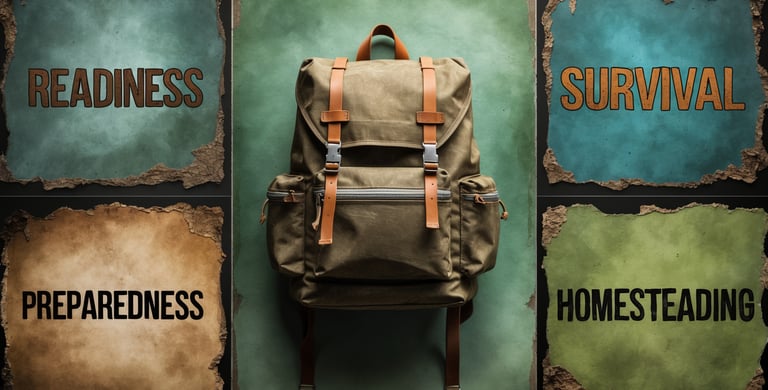Readiness: Self-Sufficiency vs. Dependence
Reclaiming the Sacred Discipline of Standing Alone
4FORTITUDER - READINESS, SURVIVAL, PREPAREDNESS, HOMESTEADING
Readiness: Self-Sufficiency vs. Dependence
Reclaiming the Sacred Discipline of Standing Alone
“No man is free who is not master of himself.”
— Epictetus
The Threshold Between Collapse and Competence
In times of peace, dependence masquerades as comfort. In times of crisis, it reveals itself as a curse. Self-sufficiency is not a fringe philosophy; it is the ancient duty of every man who claims responsibility for his own life and for those who rely on him. The line between readiness and ruin is drawn at the point where you either produce what you need—or wait for someone else to rescue you.
The Tao Te Ching warns, "He who relies on others is lost in the wind." Self-sufficiency is not selfishness. It is stewardship. It is the readiness of a man who knows the world can falter, and that his family must not fall with it.
Core Knowledge Foundation: The Mechanics of Autonomy
Self-sufficiency is a multifaceted discipline that demands operational capability across critical domains: food, water, shelter, energy, security, and medical care. It also includes financial resilience and emotional stability. Dependence, by contrast, creates systemic fragility. A man who cannot provide for himself is bound—by supply chains, government promises, or digital systems he cannot repair.
In psychological terms, self-sufficiency nurtures internal locus of control, reinforcing one’s belief that life outcomes are determined by action, not accident. This mindset is the heart of agency. Men with this frame become stable in storms; those without it drift like leaves.
In tactical application, self-sufficiency means:
Stockpiling at least 90 days of food and water.
Knowing how to purify water, generate energy, and repair your gear.
Managing health without reliance on fragile systems (basic first aid, fitness, sleep hygiene).
Establishing multiple income streams that are skill-based, not employer-based.
Learning to grow, build, fix, and defend.
Misconception Warning: Self-sufficiency is not isolationism. It is capability before reliance. The goal is interdependent strength—not passive dependence.
Advanced Insights: The Psychological and Historical Weight of Dependency
The modern world has subtly inverted the virtue of preparedness. Where once self-sufficiency was expected, now it is mocked—rebranded as paranoia or prepper extremism. But beneath every secure civilization is a backbone of men who could fix, forge, grow, and defend. Remove that, and the collapse is not far behind.
Historical Anecdote: The Siege of Leningrad (1941–1944)
For 872 days, the people of Leningrad endured starvation, bombardment, and freezing temperatures while surrounded by enemy forces. Those who survived did so not by waiting, but by adapting: growing food indoors, scavenging, learning medical improvisation, and protecting what little they had with ferocity. Self-sufficiency was no longer theory—it was the boundary between life and death.
In modern life, the siege is softer: economic instability, cyberattacks, food insecurity, supply chain disruptions. But the lesson holds:
Those who wait to prepare have already surrendered.
Tactical drills for building self-sufficiency:
Monthly audit: Can you go 72 hours without electricity, income, or supply stores? Simulate this scenario quarterly.
Skills over subscriptions: Each month, cancel one convenience (meal kits, automated deliveries) and replace it with learned skill (cooking, repairing, growing).
Critical Perspectives: Counterarguments and Their Collapse
Adversarial Viewpoint: "We live in an interconnected world. No one can be truly self-sufficient. We rely on each other—on systems, supply chains, digital infrastructure. Preparing too much is fear-driven, wasteful, or socially regressive."
The Response: Interdependence is only valuable when the individuals within the system are independently competent. Systems fail. Power grids go down. Governments falter. Communities fracture. True interdependence is not fragile collectivism; it is forged from men strong enough to carry their own weight first.
Wisdom and Warning Duality:
When Followed: Self-sufficiency breeds quiet strength. You stand taller, decide clearer, lead with calm when others panic.
When Ignored: You outsource your survival to systems that do not know your name. And when they fail, you fall with them.
Final Charge & Implementation
Self-sufficiency is sacred. It is the virtue of kings and the discipline of shepherds. Marcus Aurelius spoke of enduring with strength whatever fate delivered. But we are not only to endure—we are to prepare.
Practical implementations for today:
Construct a 30-Day Independence Map
"Self-reliance begins with inventory." — Cody Lundin
List every category: food, water, shelter, power, medical, defense. Identify one skill or supply gap in each—and schedule its resolution within 30 days.Master a Legacy Skill This Quarter
"He who does not cultivate the old will not understand the new." — Confucius (paraphrased)
Choose a generationally transferable skill: canning, woodworking, solar energy setup, animal husbandry, etc. Document and teach it.
Strategic Reflection
If all systems collapsed tonight, how many days could you lead your household before you were forced to beg or borrow?
Existential Challenge
Are you building a life your sons could inherit and continue—or are you merely consuming until the grid blinks off?
Brother, dependence is a modern disease. Self-sufficiency is the antidote passed down by your ancestors. Reclaim it, not for pride—but for legacy. Let every choice you make be one brick in the fortress your family will one day shelter in.
"The world is held together by the few who prepare when no one is watching."


